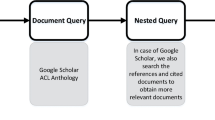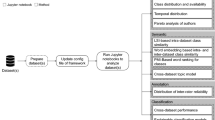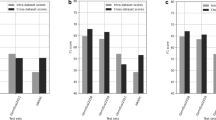Abstract
Biases can arise and be introduced during each phase of a supervised learning pipeline, eventually leading to harm. Within the task of automatic abusive language detection, this matter becomes particularly severe since unintended bias towards sensitive topics such as gender, sexual orientation, or ethnicity can harm underrepresented groups. The role of the datasets used to train these models is crucial to address these challenges. In this contribution, we investigate whether explainability methods can expose racial dialect bias attested within a popular dataset for abusive language detection. Through preliminary experiments, we found that pure explainability techniques cannot effectively uncover biases within the dataset under analysis: the rooted stereotypes are often more implicit and complex to retrieve.
Access this chapter
Tax calculation will be finalised at checkout
Purchases are for personal use only
Similar content being viewed by others
Notes
- 1.
The results of the experiments are available at https://github.com/MartaMarchiori/Exposing-Racial-Dialect-Bias.
- 2.
- 3.
- 4.
SHAP was not used on the entire test set (i.e., within the Global Explanations Section) due to the high computational costs of this explainability method. It was therefore preferred to apply it when analysing a narrower subset, i.e., in the sub-global setting.
- 5.
- 6.
References
Angerschmid, A., Zhou, J., Theuermann, K., Chen, F., Holzinger, A.: Fairness and explanation in AI-informed decision making. Mach. Learn. Knowl. Extraction 4(2), 556–579 (2022)
Balkir, E., Kiritchenko, S., Nejadgholi, I., Fraser, K.C.: Challenges in applying explainability methods to improve the fairness of NLP models. arXiv preprint arXiv:2206.03945 (2022)
Ball-Burack, A., Lee, M.S.A., Cobbe, J., Singh, J.: Differential tweetment: mitigating racial dialect bias in harmful tweet detection. In: FAccT, pp. 116–128. ACM (2021)
Baniecki, H., Kretowicz, W., Piatyszek, P., Wisniewski, J., Biecek, P.: dalex: responsible machine learning with interactive explainability and fairness in python. arXiv preprint arXiv:2012.14406 (2020)
Basile, V., Cabitza, F., Campagner, A., Fell, M.: Toward a perspectivist turn in ground truthing for predictive computing. arXiv preprint arXiv:2109.04270 (2021)
Bhargava, V., Couceiro, M., Napoli, A.: LimeOut: an ensemble approach to improve process fairness. In: Koprinska, I., et al. (eds.) ECML PKDD 2020. CCIS, vol. 1323, pp. 475–491. Springer, Cham (2020). https://doi.org/10.1007/978-3-030-65965-3_32
Binder, A., Montavon, G., Lapuschkin, S., Müller, K.-R., Samek, W.: Layer-wise relevance propagation for neural networks with local renormalization layers. In: Villa, A.E.P., Masulli, P., Pons Rivero, A.J. (eds.) ICANN 2016. LNCS, vol. 9887, pp. 63–71. Springer, Cham (2016). https://doi.org/10.1007/978-3-319-44781-0_8
Bird, S., et al.: Fairlearn: a toolkit for assessing and improving fairness in AI. Tech. Rep. MSR-TR-2020-32, Microsoft (2020)
Blodgett, S.L., Barocas, S., Daumé III, H., Wallach, H.: Language (technology) is power: a critical survey of “bias” in NLP. In: Proceedings of the 58th Annual Meeting of the Association for Computational Linguistics, pp. 5454–5476 (2020)
Blodgett, S.L., Green, L., O’Connor, B.: Demographic dialectal variation in social media: a case study of african-american english. In: Proceedings of EMNLP (2016)
Bodria, F., Giannotti, F., Guidotti, R., Naretto, F., Pedreschi, D., Rinzivillo, S.: Benchmarking and survey of explanation methods for black box models. CoRR abs/2102.13076 (2021)
Caselli, T., Basile, V., Mitrović, J., Kartoziya, I., Granitzer, M.: I feel offended, don’t be abusive! implicit/explicit messages in offensive and abusive language. In: Proceedings of the 12th Language Resources and Evaluation Conference, pp. 6193–6202. European Language Resources Association, Marseille, France (2020). https://www.aclweb.org/anthology/2020.lrec-1.760
Dalvi, F., et al.: Neurox: a toolkit for analyzing individual neurons in neural networks. In: Proceedings of the AAAI Conference on Artificial Intelligence (AAAI) (2019)
Davidson, T., Bhattacharya, D., Weber, I.: Racial bias in hate speech and abusive language detection datasets. arXiv preprint arXiv:1905.12516 (2019)
Devlin, J., Chang, M.W., Lee, K., Toutanova, K.: Bert: pre-training of deep bidirectional transformers for language understanding. arXiv preprint arXiv:1810.04805 (2018)
Devlin, J., Chang, M.W., Lee, K., Toutanova, K.: BERT: pre-training of deep bidirectional transformers for language understanding. In: Proceedings of the 2019 Conference of the North American Chapter of the Association for Computational Linguistics: Human Language Technologies, Volume 1 (Long and Short Papers), pp. 4171–4186. Association for Computational Linguistics (2019)
Dixon, L., Li, J., Sorensen, J., Thain, N., Vasserman, L.: Measuring and mitigating unintended bias in text classification. In: AIES, pp. 67–73. ACM (2018)
Doshi-Velez, F., Kim, B.: Towards a rigorous science of interpretable machine learning. arXiv preprint arXiv:1702.08608 (2017)
Founta, A., et al.: Large scale crowdsourcing and characterization of twitter abusive behavior. In: ICWSM, pp. 491–500. AAAI Press (2018)
Freitas, A.A.: Comprehensible classification models: a position paper. SIGKDD Explor. 15(1), 1–10 (2013)
Guidotti, R., Monreale, A., Ruggieri, S., Turini, F., Giannotti, F., Pedreschi, D.: A survey of methods for explaining black box models. ACM Comput. Surv. 51(5), 1–42 (2019)
Hochreiter, S., Schmidhuber, J.: Long short-term memory. Neural Comput. 9(8), 1735–1780 (1997)
Holzinger, A., Saranti, A., Molnar, C., Biecek, P., Samek, W.: Explainable AI methods-a brief overview. In: Holzinger, A., Goebel, R., Fong, R., Moon, T., Müller, K.R., Samek, W. (eds.) xxAI - Beyond Explainable AI. xxAI 2020. LNCS, vol. 13200, pp. 13–38. Springer, Cham (2022). https://doi.org/10.1007/978-3-031-04083-2_2
Kiritchenko, S., Nejadgholi, I., Fraser, K.C.: Confronting abusive language online: a survey from the ethical and human rights perspective. J. Artif. Intell. Res. 71, 431–478 (2021)
Kowsari, K., Jafari Meimandi, K., Heidarysafa, M., Mendu, S., Barnes, L., Brown, D.: Text classification algorithms: a survey. Information 10(4), 150 (2019)
Liu, Y., et al.: Roberta: a robustly optimized bert pretraining approach. arXiv preprint arXiv:1907.11692 (2019)
Longo, L., Goebel, R., Lecue, F., Kieseberg, P., Holzinger, A.: Explainable artificial intelligence: concepts, applications, research challenges and visions. In: Holzinger, A., Kieseberg, P., Tjoa, A.M., Weippl, E. (eds.) CD-MAKE 2020. LNCS, vol. 12279, pp. 1–16. Springer, Cham (2020). https://doi.org/10.1007/978-3-030-57321-8_1
Lundberg, S.M., Lee, S.: A unified approach to interpreting model predictions. In: NIPS, pp. 4765–4774 (2017)
Mikolov, T., Chen, K., Corrado, G., Dean, J.: Efficient estimation of word representations in vector space. In: 1st International Conference on Learning Representations, ICLR 2013, Scottsdale, Arizona, USA, 2–4 May 2013, Workshop Track Proceedings (2013)
Ntoutsi, E., et al.: Bias in data-driven artificial intelligence systems - an introductory survey. Wiley Interdiscip. Rev. Data Min. Knowl. Discov. 10(3), e1356 (2020)
Pedreschi, D., et al.: Open the black box data-driven explanation of black box decision systems. CoRR abs/1806.09936 (2018)
Pennington, J., Socher, R., Manning, C.D.: Glove: Global vectors for word representation. In: Empirical methods in natural language processing (EMNLP), pp. 1532–1543 (2014)
Peters, M.E., et al.: Deep contextualized word representations. In: NAACL-HLT, pp. 2227–2237. Association for Computational Linguistics (2018)
Ribeiro, M.T., Singh, S., Guestrin, C.: why should I trust you?: explaining the predictions of any classifier. In: KDD, pp. 1135–1144. ACM (2016)
Ribeiro, M.T., Singh, S., Guestrin, C.: Anchors: High-precision model-agnostic explanations. In: AAAI, pp. 1527–1535. AAAI Press (2018)
Samek, W., Montavon, G., Lapuschkin, S., Anders, C.J., Müller, K.: Toward interpretable machine learning: transparent deep neural networks and beyond. CoRR abs/2003.07631 (2020)
Sanh, V., Debut, L., Chaumond, J., Wolf, T.: Distilbert, a distilled version of Bert: smaller, faster, cheaper and lighter. arXiv preprint arXiv:1910.01108 (2019)
Sap, M., Card, D., Gabriel, S., Choi, Y., Smith, N.A.: The risk of racial bias in hate speech detection. In: ACL (1), pp. 1668–1678. Association for Computational Linguistics (2019)
Sokol, K., Hepburn, A., Poyiadzi, R., Clifford, M., Santos-Rodriguez, R., Flach, P.: FAT forensics: a python toolbox for implementing and deploying fairness, accountability and transparency algorithms in predictive systems. J. Open Source Softw. 5(49), 1904 (2020)
Sundararajan, M., Taly, A., Yan, Q.: Axiomatic attribution for deep networks. In: International Conference on Machine Learning, pp. 3319–3328. PMLR (2017)
Suresh, H., Guttag, J.V.: A framework for understanding unintended consequences of machine learning. CoRR abs/1901.10002 (2019)
Vashishth, S., Upadhyay, S., Tomar, G.S., Faruqui, M.: Attention interpretability across NLP tasks. arXiv preprint arXiv:1909.11218 (2019)
Vaswani, A., et al.: Attention is all you need. In: NIPS, pp. 5998–6008 (2017)
Vaswani, A., et al.: Attention is all you need. In: Proceedings of the 31st International Conference on Neural Information Processing Systems, pp. 6000–6010. NIPS2017, Curran Associates Inc., Red Hook, NY, USA (2017)
Wang, T., Saar-Tsechansky, M.: Augmented fairness: an interpretable model augmenting decision-makers’ fairness. arXiv preprint arXiv:2011.08398 (2020)
Wiegand, M., Ruppenhofer, J., Kleinbauer, T.: Detection of abusive language: the problem of biased datasets. In: Proceedings of the 2019 Conference of the North American Chapter of the Association for Computational Linguistics: Human Language Technologies, pp. 602–608 (2019)
Zampieri, M., et al.: Semeval-2020 task 12: multilingual offensive language identification in social media (offenseval 2020). In: SemEval@COLING, pp. 1425–1447. International Committee for Computational Linguistics (2020)
Acknowledgements
This work has been partially supported by the European Community Horizon 2020 programme under the funding schemes: H2020-INFRAIA-2019-1: Research Infrastructure G.A. 871042 SoBigData++, G.A. 952026 HumanE AI Net, ERC-2018-ADG G.A. 834756 XAI: Science and technology for the eXplanation of AI decision making), G.A. 952215 TAILOR.
Author information
Authors and Affiliations
Corresponding author
Editor information
Editors and Affiliations
Rights and permissions
Copyright information
© 2023 The Author(s), under exclusive license to Springer Nature Switzerland AG
About this paper
Cite this paper
Manerba, M.M., Morini, V. (2023). Exposing Racial Dialect Bias in Abusive Language Detection: Can Explainability Play a Role?. In: Koprinska, I., et al. Machine Learning and Principles and Practice of Knowledge Discovery in Databases. ECML PKDD 2022. Communications in Computer and Information Science, vol 1752. Springer, Cham. https://doi.org/10.1007/978-3-031-23618-1_32
Download citation
DOI: https://doi.org/10.1007/978-3-031-23618-1_32
Published:
Publisher Name: Springer, Cham
Print ISBN: 978-3-031-23617-4
Online ISBN: 978-3-031-23618-1
eBook Packages: Computer ScienceComputer Science (R0)




